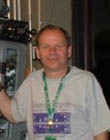|
|
 
|
|
Author
|
Topic: Any telephone engineers here?
|
Stephen Furley
Film God

Posts: 3059
From: Coulsdon, Croydon, England
Registered: May 2002
|
 posted 05-16-2009 04:54 AM
posted 05-16-2009 04:54 AM




As well as looking after the system at work (Mitel 3300 ICP) with about two-thirds analogue extensions connected via SX-1000 Lite cabinets and the other third IP via Extreme power over Ethernet switches) I also collect telephones. I recently won a strange one on Ebay, and I'm wondering if anyboby knows anything about it.
It's an engineers test set, I think they're sometimes called 'Butt sets' over there, but unlike any others I've seen. It's made by CMC, which seems to stand for Communications Manufacturing Company, or possibly Corporation, and is a 'TRUB-L-SHOOTER' It's bright yellow, and from the design I'd guess is probably '70s or early '80s, though the cord is cloth, both outer and inner, which looks older. It's also a different plastic to these things are usually made of.
The most unusual thing about it is that it has both a dial (for LD) and a keypad (for DTMF), rather than using a keypad which can be switched to do either. The dial is a small one with a moving finger stop, wery similar to the one which was used on the Contempra telephone if anybody remembers that. This is on the back of the earpiece, and the keypad is in the centre of the other side. There's a knob at the top marked 'D' and 'M', it siezes the line when switched to D, I assume M is for monitor, but I can't think what D stands for. There's also a three-position rocker switch, which springs to the centre position. The two ends are marked 'TLK', (presumably 'Talk') which will also seize the line for as long as it's held in this position' and 'RLS', which seems to perform what we would call a Timed Break Recall function, I think you call it a Flash' over there. The cord is a three conductor one, fitted with ordinary clips, not 'Bed o' Nails' type. The colours are rather faded, but the cores are coloured red, white and blue. The white and blue ones are the line, it doesn't seem to care about polarity. The red wire has been strapped back out of the way with a couple of small cable ties, so it obviously wasn't being used. Any idea what this is for? Your 'phones don't use a third wire for ringing like ours do, and even here test sets, and some newer ordinary 'phones don't need this. The other main use for a third wire is for an earth connection, but this thing doesn't seem to be able to do earth recall, and it hasn't got a 'Call Exchange' type button for shared service use; any ideas?
I've had a look around, but I can't find a website for the company, or a manual for the 'phone. There are a couple listed for sale for about $25, rather more than I paid for mine.
| IP: Logged
|
|
|
|
|
|
Stephen Furley
Film God

Posts: 3059
From: Coulsdon, Croydon, England
Registered: May 2002
|
 posted 05-16-2009 09:13 AM
posted 05-16-2009 09:13 AM




Hi Rick,
I'd forgotten you were a telephone man. I don't have a digital camera, and I don't have time to process and scan film at the moment. I'm away from work now until Wednesday; I'm going to a documentary film show in Sheffield on Monday, coming back on the overnight bus, and I've then got Tuesday off work to recover from the horrible journey home.
I'll post some pictures next week, but in the meantime you should still be able to see the ones on Ebay:
web page
The dial behind the earpiece thing is quite common, I've got an old GPO Telephone 280 Mk.2 from the '50s which has this, but with a conventional type dial, albeit a small one, with rather small finger holes. Modern ones are generally switchable to either LD or DTMF, but do both via the same keypad; I've never seen one with both a dial and a keypad before.
The moving finger stop dial was a clever idea where a small dial was needed; this one turns through very slightly more than 360 degrees when '0' is dialled, the one on my Contempra turns slightly more, but is very similar.
There are small sleeves over each wire; two of these are marked 'T' and 'R'. There is a letter on the third wire, but it's rather worn, and I can't make out what it is.
Any idea when DTMF signalling was introduced over there; that would give an early limit for the age of the thing? We were very late introducing it here; many public exchanges didn't support it until well into the '80s, though PABXs tended to have it earlier. You often had to start off in LD mode to talk to the BT exchange, and then switch to DTMF part way through if you were dialing through via another system such as Mercury; thankfully that's a thing of the past now. As for as I know, all BT exchanges, and most PABXs still support lD, though certain other service providers, VoIP systems, ISDN ATAs etc. do not.
[ 05-16-2009, 02:08 PM: Message edited by: Adam Martin ]
| IP: Logged
|
|
|
|
|
|
|
|
|
|
|
|
All times are Central (GMT -6:00)
|
|
Powered by Infopop Corporation
UBB.classicTM
6.3.1.2
The Film-Tech Forums are designed for various members related to the cinema industry to express their opinions, viewpoints and testimonials on various products, services and events based upon speculation, personal knowledge and factual information through use, therefore all views represented here allow no liability upon the publishers of this web site and the owners of said views assume no liability for any ill will resulting from these postings. The posts made here are for educational as well as entertainment purposes and as such anyone viewing this portion of the website must accept these views as statements of the author of that opinion
and agrees to release the authors from any and all liability.
|

 Home
Home
 Products
Products
 Store
Store
 Forum
Forum
 Warehouse
Warehouse
 Contact Us
Contact Us




 Printer-friendly view of this topic
Printer-friendly view of this topic













